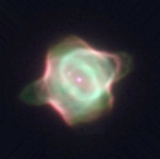
Stingray Nebula
Encyclopedia
The Stingray Nebula is the youngest known planetary nebula
(PN). The Stingray is located in the direction of the southern constellation
Ara
(the Altar), and is located 18,000 light-years away. Although it is some 130 times the size of our solar system, the Stingray Nebula is only about 1/10 the size of most other known planetary nebulae. Forty years ago it was still a protoplanetary nebula in which the gas had not yet become hot and ionized. In a Nature article, Bobrowsky et al. described how the Hubble observations revealed a 17th-magnitude companion to the Stingray's 15th-magnitude central star. The image of the Stingray Nebula shown here shows how the outer shells of gas are collimating
the continuing outflow of gas from the central star -- an important observation, as the process of how these outflows become collimated has not been well understood.
classified as an A or B type Hα
emission line star in 1967. It was observed in 1971 to be a pre-planetary nebula
(PPNe) when it seemed to be an asymptotic giant branch
(AGB) B1 supergiant
. Planetary nebula (PN) emission lines were identified in this star in 1989 by the IUE (Parthasarathy et al. 1993). As the nebula would be newly formed and very small, ground-based observations were not able to resolve it; so Bobrowsky observed it with the Hubble Space Telescope, discovering the nebula, which he named the "Stingray Nebula."
, having seemingly faded by a factor of three between 1987 and 1995. The PNN has an estimated mass of 0.6 M☉
, and has an observed companion star separated by 0.3 arcsec. Nebula mass is estimated as 0.015 M☉.
Luminosity is estimated to be 3000 L☉.
Planetary nebula
A planetary nebula is an emission nebula consisting of an expanding glowing shell of ionized gas ejected during the asymptotic giant branch phase of certain types of stars late in their life...
(PN). The Stingray is located in the direction of the southern constellation
Ara
Ara (constellation)
Ara is a southern constellation situated between Scorpius and Triangulum Australe. Its name is Latin for "altar". Ara was one of the 48 Greek constellations described by the 2nd century astronomer Ptolemy, and it remains one of the 88 modern constellations defined by the International Astronomical...
(the Altar), and is located 18,000 light-years away. Although it is some 130 times the size of our solar system, the Stingray Nebula is only about 1/10 the size of most other known planetary nebulae. Forty years ago it was still a protoplanetary nebula in which the gas had not yet become hot and ionized. In a Nature article, Bobrowsky et al. described how the Hubble observations revealed a 17th-magnitude companion to the Stingray's 15th-magnitude central star. The image of the Stingray Nebula shown here shows how the outer shells of gas are collimating
Collimated light
Collimated light is light whose rays are parallel, and therefore will spread slowly as it propagates. The word is related to "collinear" and implies light that does not disperse with distance , or that will disperse minimally...
the continuing outflow of gas from the central star -- an important observation, as the process of how these outflows become collimated has not been well understood.
History
Prior to the discovery of the nebula, the central star of the Stingray Nebula was known as He3-1357, which Karl Gordon HenizeKarl Gordon Henize
Karl Gordon Henize[p], Ph.D. was an astronomer, NASA astronaut, space scientist, and professor at Northwestern University. He was stationed at several observatories around the world, including McCormick Observatory, Lamont-Hussey Observatory , Mount Wilson Observatory, Smithsonian Astrophysical...
classified as an A or B type Hα
H-alpha
H-alpha is a specific red visible spectral line created by hydrogen with a wavelength of 656.28 nm, which occurs when a hydrogen electron falls from its third to second lowest energy level...
emission line star in 1967. It was observed in 1971 to be a pre-planetary nebula
Protoplanetary nebula
A protoplanetary nebula or preplanetary nebula is an astronomical object which is at the short-lived episode during a star's rapid stellar evolution between the late asymptotic giant branch phase and the subsequent planetary nebula phase. A PPN emits strongly in infrared radiation, and is a...
(PPNe) when it seemed to be an asymptotic giant branch
Asymptotic Giant Branch
The asymptotic giant branch is the region of the Hertzsprung-Russell diagram populated by evolving low to medium-mass stars. This is a period of stellar evolution undertaken by all low to intermediate mass stars late in their lives....
(AGB) B1 supergiant
Supergiant
Supergiants are among the most massive stars. They occupy the top region of the Hertzsprung-Russell diagram. In the Yerkes spectral classification, supergiants are class Ia or Ib . They typically have bolometric absolute magnitudes between -5 and -12...
. Planetary nebula (PN) emission lines were identified in this star in 1989 by the IUE (Parthasarathy et al. 1993). As the nebula would be newly formed and very small, ground-based observations were not able to resolve it; so Bobrowsky observed it with the Hubble Space Telescope, discovering the nebula, which he named the "Stingray Nebula."
Planetary nebula nucleus (PNN)
In 1995 the central planetary nebula nucleus (PNN) was observed as a DA white dwarfWhite dwarf
A white dwarf, also called a degenerate dwarf, is a small star composed mostly of electron-degenerate matter. They are very dense; a white dwarf's mass is comparable to that of the Sun and its volume is comparable to that of the Earth. Its faint luminosity comes from the emission of stored...
, having seemingly faded by a factor of three between 1987 and 1995. The PNN has an estimated mass of 0.6 M☉
Solar mass
The solar mass , , is a standard unit of mass in astronomy, used to indicate the masses of other stars and galaxies...
, and has an observed companion star separated by 0.3 arcsec. Nebula mass is estimated as 0.015 M☉.
Luminosity is estimated to be 3000 L☉.

